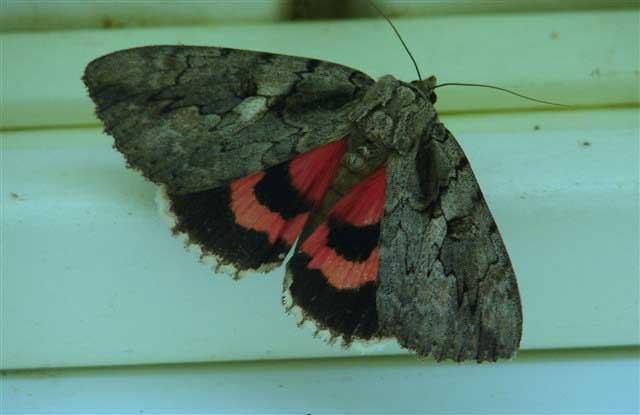
Catocala amatrix, Newport, Orleans County, Vermont,
September 5, 2011, courtesy of Jane Housewright.

Catocala amatrix, Newport, Orleans County, Vermont,
September 5, 2011, courtesy of Jane Housewright.
I have added some species, marked unconfirmed, based on records from Quebec and/or Ontario combined with records from New Hampshire and/or other nearby states.
I have begun to include thumbnails of some of the various forms. Over time I hope to have them all covered.
Please help me improve the documented accuracy of this site by sending sighting data (date and location, bait, flowers, lights) and electronic images to Bill Oehlke. I will do my best to identify specimens if you need/want assistance. All images that I post on my websites are credtied to respective photographers and remain the property of the photographers.
As of April 4, 2010, this page has been further updated as per research data compiled by Larry Gall.
I would like to continue to refine the listings to county levels so images and data (date, location at least to county level,
bait, lights) would be very much appreciated. Please send same to Bill Oehlke.
All images that I use on my websites remain the property of respective photographers and images are credited as such.
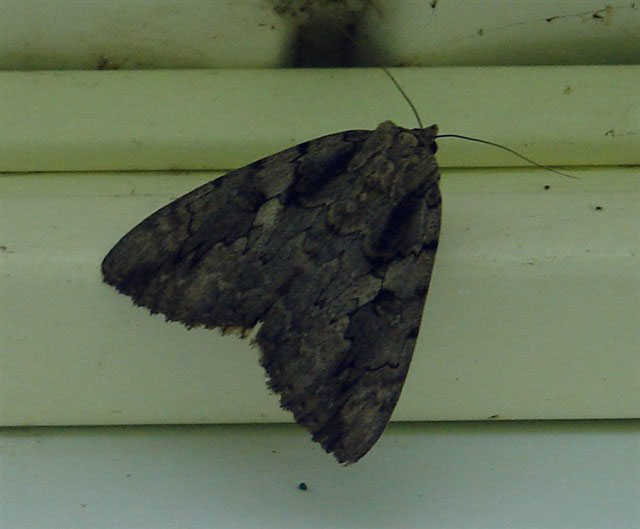
Catocala amatrix, Newport, Orleans County, Vermont,
September 5, 2011, courtesy of Jane Housewright.
Many thanks also to JoAnne Russo who has sent images of Catocala cara and Catocala concumbens from Saxtons River, Windham County, southeastern Vermont. The Identification Keys Diagram should help you understand the terminology I have used in describing the various species.
Visit Vermont Sphingidae: Hawk Moths.
Little Yellow-Orange Underwings: Wingspans: 35-45mm
Little Yellow-Orange Underwings: Wingspans: 35-56mm |
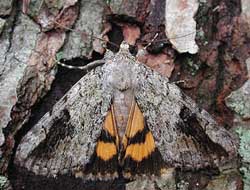
| ** 8876 Catocala micronympha, the Little Nymph Underwing, (wingspan: 35-50mm). John Himmelman image. Usual specimens have grey forewings shaded with green, brown, black and white tints. Usually a darkened band passing from costa through reniform spot to outer margin. High variability. Full size Joe Garris photo of C. micronympha form hero. |
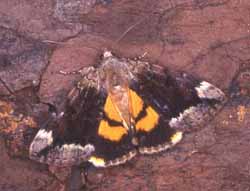
| ** 8876 Catocala micronympha
form gisela,
the Little Nymph Underwing, (wingspan: 35-50mm). |
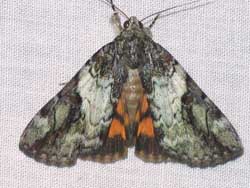
| ** 8876 Catocala micronympha
form hero,
the Little Nymph Underwing, (wingspan: 35-50mm).
The usual specimens have grey forewings shaded with green, brown,
black and white tints. There is usually a darkened band passing from
the costa through the reniform spot to the outer margin.
Form "hero" H. Edwards has a median area that is mostly white. |
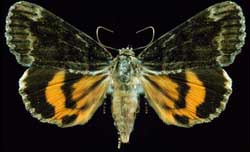
| ** 8876 Catocala micronympha form lolita, the Little Nymph Underwing, (wingspan: 35-50mm).Form "lolita" Sargent has very dark forewings. Harold J. Vermes image, used with permission from his son. |
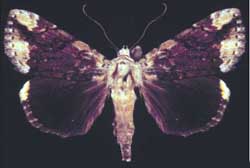
| ** 8876 Catocala micronympha form sargenti, the Little Nymph Underwing, (wingspan: 35-50mm). Usual specimens have grey forewings shaded with green, brown, black and white tints. Usually a darkened band passing from costa through reniform spot to outer margin. Form "sargenti" Covell (very rare) has a hindwing that is all black. |
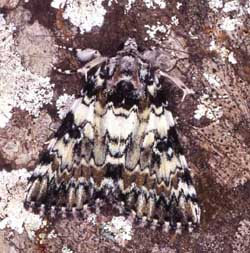
| ** 8877 connubialis, Connubial Underwing, (wingspan: 35-50mm). unconfirmed FW highly variable. Several different forms: "sancta" Hulst: typical form; fws with white ground colour and sharply contrasting black lines and markings. There is also brown shading between pm and subterminal lines; "cordelia" H. Edwards: coloured as above but markings are faint; "pulverulenta" Brower: grey-green fws with faint markings, sometimes none; "broweri" Muller: melanic form with fws that are dark green, almost black. Hw: separate anal spot and outer band ends with straight cut. |
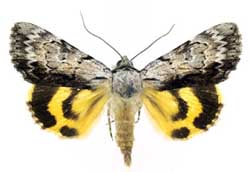
| ** 8847
gracilis,
Graceful Underwing, (wingspan: 40-45mm):
Gracilis closely resembles sordida but the hindwing loop is not
complete in gracilis as it is in sordida. |
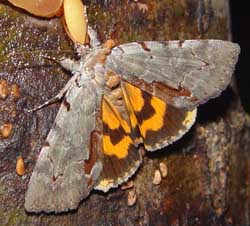
| ** 8864 Catocala grynea ; Woody Underwing, wingspan: 40-50mm: The forewing is a dull greenish grey with orangey-brown shading along the inner margin. The antemedial, median and postmedial lines are quite faint.
Praeclara is somewhat similar but has a break in the brown shading
between the am and pm lines. Praeclara also has a paler orange
hindwing color. |
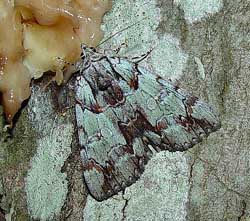
| ** 8865 praeclara; Praeclara Underwing, wingspan: 40-50mm: Fw is pale greenish-grey with considerable contrasting brown shading beyond post medial line.There is black basal dash very close to inner margin and another dash, higher up in median area. Note the contrasting shapes of the reniform and subreniform spots. Tim Dyson image. |
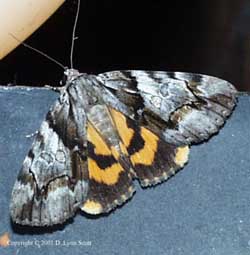
| ** 8867 Catocala blandula;
Charming Underwing, wingspan: 40-50mm. |
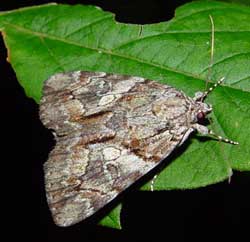
| Catocala mira; Wonderful Underwing, wingspan: 40-50mm. Pale basal area of fw distinguishes mira from blandula (dark brown) and crataegi (black). Fw lacks dark contrasting lines of crataegi and blandula. Considerable brown in subterminal area and subreniform spot very conspicuous, usually brown. Light area runs obliquely from costa to subreniform spot. Noticeable space along i. m. between antemedial and postmedial lines. Hw deep orange and has a complete inner black band. The outer black band is unbroken Tim Dyson image. |
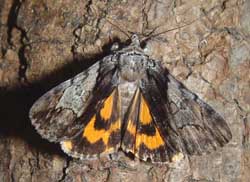
| ** 8858 Catocala crataegi DL; Hawthorn Underwing, wingspan: 40-50mm: Determination is based on dark (black) shading in forewing basal area continuing along inner margin to anal angle and brown shading beyond postmedial line. There is also a definite greenish cast to median area. Hw has outer black band, broken near the anal angle, distinguishing crataegi from blandula. Tim Dyson image. |
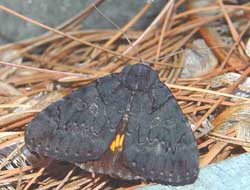
| ** 8775 antinympha; Sweetfern Underwing, wingspan 45-55mm.: The very dark grey, almost black, forewing ground colour distinguishes antinympha. There is some brown shading in the subreniform spot and also just outside the postmedial line. The hindwing is amber to pale orange. There is also the form multoconspicua Reiff, 1919 with a pale, almost white subreniform spot. Tim Dyson image. |
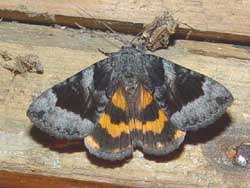
| ** 8776 badia coelebs; Old Maid Underwing, wingspan 54-56mm: unconfirmed The gray region from the forewing pm line to the outer margin readily distinguishes this species. The fringe is gray on the lower wing from the brief orange dash at the hindwing apex to the anal angle.Tim Dyson image. |
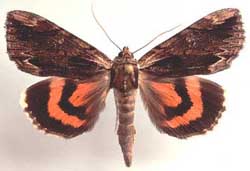
| ** 8857 Catocala ultronia; Ultronia Underwing, wingspan: 50-63mm.Fws typically gray-brown, with a distinct and very dark inner margin and characteristic light brown patch, underscored by very dark arc, near wingtip. Underwings can be yellow to orange to salmon. |
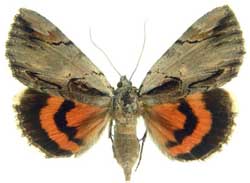
| ** 8857 Catocala ultronia form lucinda; Ultronia Underwing, wingspan: 50-63mm.In form lucinda most of the forewing is bright grey. On all forms there is
extensive orange-salmon colouration on hw ventral surface,
and there is a dark discal lunule. |
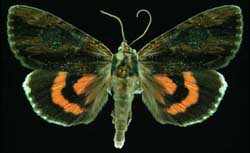
| Catocala ultronia, form nigrescens, the Ultronia Underwing, wingspan: 50-63mm. In the melanic form nigrescens, the dorsal forewing is very dark. Even darker subapical arc, basal dash and dash near anal angle are still visible. Dark basal hairs on hindwing. Harold J. Vermes slide, used with permission from his son. |
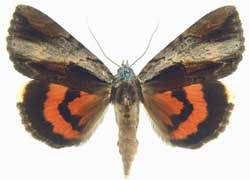
| Catocala ultronia form celia.
In form celia there is a wide, light grey band separating a dark region along inner margin and
a dark patch near the apex.
The ventral surface of forewings of all forms has a generous suffusion
of orange-salmon scales in the lower half of the median area. |
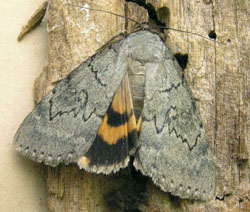 |
** 8779 serena Serene Underwing unconfirmed The head and collar and abdomen are brown while the thorax is grey. The am and pm lines are thin but very dark and distinct on an otherwise drab, almost uniformly olive-grey forewing. The black marginal band of the lower wings is indented at the center, and the relatively narrow, deep yellow median band parallels this indentation. Basal hairs are brown. Catocala serena courtesy of Carroll Rudy, July 28, Calumet County. |
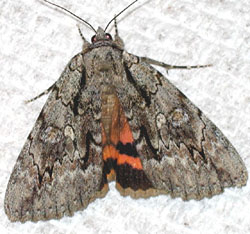
| #8778 Catocala habilis; 55-65mm: Large thoracic "M" and "pork chop" shaped, light sbrnfrm spot becoming very dark in constriction at juncture with narrow, dark, distinct pm line. Pm line outwardly lined with narrow suffusion of white scales, followed by broader brown scaled band, another broader suffusion of white scales up to very regular dentation of sbtrmnl line. Always significant "bleeding" of yellow-orange to salmon scales into hw fringes. Large reniform spot brown center, faintly edged with black, white, black again. |
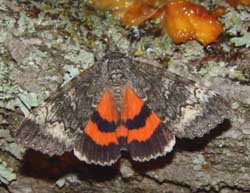
| #8817 briseis; Briseis Underwing; 60-70mm: Fws predominantly mottled dark-grey-brown with some lighter areas 1) between pm and subterminal lines, 2) at very base of am pm lines along inner margin, and 3) over subreniform spot running diagonally toward costa. Pm lines have no greatly elongated and sharly pointed "teeth" near apex. Hw fringe white and unbroken and inner black band (fairly even) reaches i. m.. |
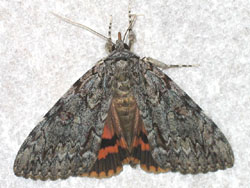
| #8795 Catocala palaeogama ; wingspan: 60-70mm. Subreniform spot closed, does not approach pm line, is smaller than in C. habilis. All forms have characteristic orange, heavily barred fringe to apex, and irregular bands on hws. Hw basal median area heavily suffused with dark brown to black scales. Dark bar in outer half of median area, paralleling i. m. halfway between i. m. and light, closed subreniform spot. Joe Garris photo. |
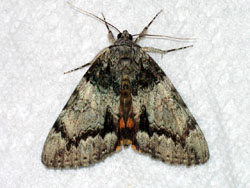
| #8795 Catocala palaeogama form phalanga; wingspan: 60-70mm. In this form, fw basal area and subterminal area are very dark against a much lighter background. Dark bar in the outer half of the median area, paralleling the inner margin halfway between the inner margin and the light, closed subreniform spot is especially evident. Joe Garris image. |
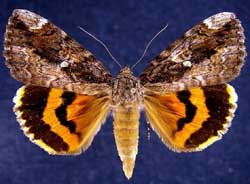
| ** 8770 Catocala innubens; Betrothed; 55-72mm. Forewing is mottled with white, grey and brown, and subrenifrom spot tends to be lighter in colour, although it is sometimes obscured by an indistinct blackish bar which runs from middle of basal/thorax connection to just below much lighter apex at outer margin.Jim Vargo image. |
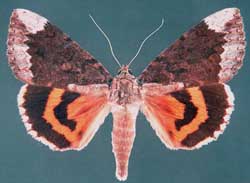
| ** 8770 Catocala innubens form scintillans; Betrothed; 55-72mm.In form scintillans most of the basal area (all but lower third) and all of the median area of the forewing is dark reddish brown. The area outside the pm line is grey. Vernon A Brou image. |
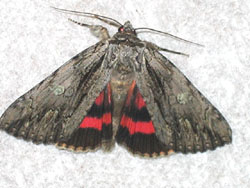
| ** 8851 Catocala coccinata; Scarlet; wingspan: 57-70mm: Usually diffuse basal, anal dashes on light grey, mottled fw. Hw fringe white (often with some salmon scaling) and heavily checked. "Tooth" just below pair of very elongated "teeth" much reduced, quite rounded, usually allowing considerable room for lighter patch of scales. Dark bar crosses thorax. Reniform spot light, often with greenish cast. Joe Garris image. |
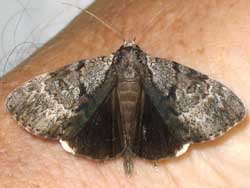
| Catocala andromedae tristis, Gloomy Underwing, (wingspan: 40-50mm). unconfirmed Black underwings and dark grey hw fringe, coupled with dark fw inner margin help to identify this species. Very dark "flying saucer" shape adjoins subreniform spot to midpoint of antemedial line. "Teeth" of postmedian line short, blunt, outwardly edged with white. Subterminal line also outwardly edged with white. |
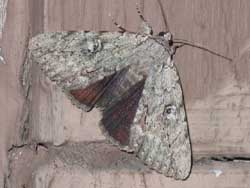
| ** 8781 judith, Judith's Underwing, (wingspan: 45-55mm), smaller "black" underwing. Fw uniform light grey with thin and only slightly darkened antemedial, median and postmedial lines. No darkened dashes (slight anal dash) or transverse lines. Reniform area is slightly darkened while the area just before subterminal line is a bit lighter. Note absence of hw white fringe. Joe Garris photo. |
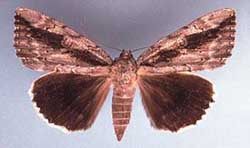
| ** 8782 Catocala flebelis unconfirmed; Mournful Underwing, wingspan: 54-65mm; Diffuse black band runs from basal area to o. m. just below apex, interrupted by pale grey subreniform spot. Reniform spot filled with brown, additional brown outside pm line. No anal dash as in angusi. Hws have white fringe. Probably only in southern counties; rare, if present. |
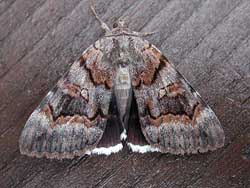
| ** 8773
Catocala epione ;
Epione Underwing, wingspan: 55-65mm |
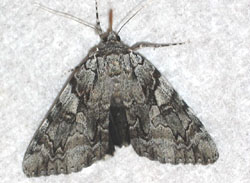
| ** 8790 Catocala dejecta unconfirmed, (wingspan: 56-73mm). Quite similar to Catocala retecta. Light coloured subreniform spot open, but has distinct "pork-chop" shape, separates a much darker median area below subreniform spot from very light area to costa above spot. Lower quarter of submarginal area also much darker in C. dejecta than in C. retecta. If present, probably only in southern counties. rare, if present |
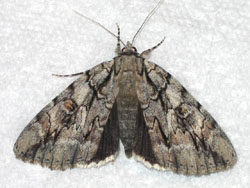
| Catocala retecta; wingspan: 60-75mm. Note light coloured, elongated, open subreniform spot interrupting dark, diffuse ark running through center of wing from basal area (body-wing juncture) to fw apex. Center of reniform spot brown, brown area just below costa running to i. m. just outside pm line. Off-white hw fringe only lightly checked along the wing veins. Joe Garris image. |
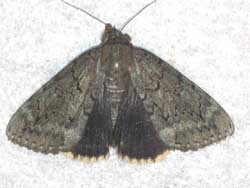
| ** 8784 obscura unconfirmed; Obscure Underwing, (wingspan: 60-72mm): dull, grey fws, usually void of any significant dashes or streaks, providing for easy identification. Antemedial, median and postmedial lines of obscura are faint, and subterminal line region is only slightly paler than the rest of the forewing. The hindwing fringe is off-white and lightly checked on the veins. Joe Garris photo. |
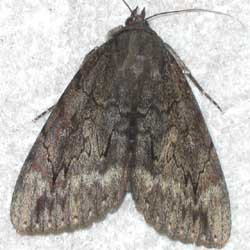
| Catocala residua,
Residua Underwing, yes, (wingspan: 58-73mm),
Distinguished from C. obscura by grey hindwing
fringe of residua.
C. obscura has white to off-white fringe, tends to be
less common in northern portions of its range. Fw
subterminal line/area of C. residua tends to be pale as
is its open, elongated subreniform spot. |
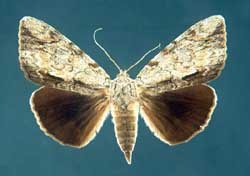
| ** 8791
Catocala insolabilis unconfirmed;
Inconsolable, wingspan: 65-75mm
|
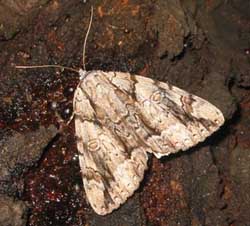
| ** 8792 Catocala vidua, unconfirmed; Widow; wingspan: 70-80mm. Fw ground colour light grey. Distinguished dark arc runs through top of reniform spot to just below apex. Heavy, dark anal, basal dashes, connecting to dark median bar, running parallel to im. Aml thick, black in upper half. Reniform spot consists of two almost concentric irregular ovals. Subreniform spot light, open, but constricted as it meets pm line. Hw black with broad, white fringe, only lightly interrupted. Marie Winn image. |
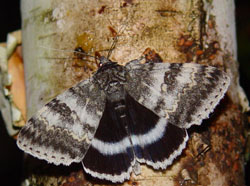
| ** 8803 Catocala relicta
;
Forsaken, White, Relict; 70-80mm:
Considerable variation with regard to black/white
concentrations on fws. |
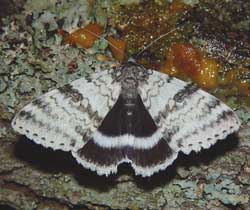
| ** 8803 Catocala relicta ; Forsaken, White, Relict; 70-80mm: Considerable variation with regard to black/white concentrations on fws. Form clara: basal and subterminal areas predominantly white.Typical specimens have basal and subterminal areas with blackish scales. Black hws, with brilliant even white inner band and white fringe, are distinctive. June until October. |
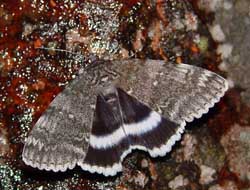
| ** 8803 Catocala relicta ; Forsaken, White, Relict; 70-80mm: Considerable variation with regard to black/white concentrations on fws. Form phrynia: evenly dusted with grey over entire forewing. Typical specimens have basal and subterminal areas with blackish scales. Black hws, with brilliant even white inner band and white fringe, are distinctive. June until October, poplars and willows |
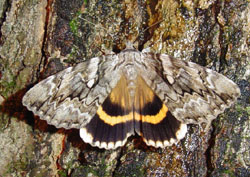
| ** 8802 Catocala cerogama; Yellow-Banded; 70-80mm. There are several different forms. The pm line is distinct, dark and has an elongate pair of projections. The pm and am lines meet the inner margin in relative proximity. The closed subreniform spot it lighter than surrounding areas, and it is shaped a bit like an arrowhead with the point toward the body. The hindwings are distinctive. Jean-Benoît Duval image. |
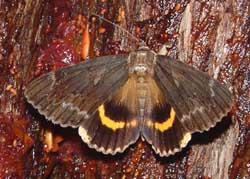
| ** 8802 Catocala cerogama; Yellow-Banded; 70-80mm.Form ruperti: Forewings are almost uniform grey-brown with white scales outlining subterminal line. The hindwings are distinctive. Tim Dyson image. |
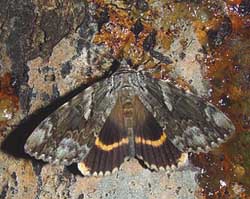
| ** 8802 Catocala cerogama; Yellow-Banded; 70-80mm.Form bunkeri: Forewings are dark in median and basal areas. Hw golden band is reduced in thickness. Basal hairs are brown instead of yellow. The hindwings are distinctive. Tim Dyson image. |
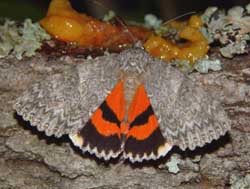
|
** 8822 meskei; Meske's Underwing; wingspan: 65-75mm: Forewings less distinctly marked compared to unijuga with some red-orange at hw apex and just inside fringe along the outer margin in meskei that is lacking in unijuga. Forewing subreniform spot is opened or connected to postmedian line. Hindwing postmedian band is nearly straight, turned in and tapering near anal angle. Tim Dyson image. |
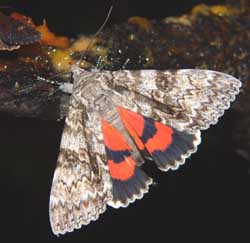
|
** 8821 semirelicta; Semirelict Underwing; wingspan: 65-75mm: Forewing ground colour is white with dark lines and shadings. Diffuse dark bar runs from center of basal area to outer margin a few mm above anal angle. Note regular dentation of st line. Inner black bar on the lower wing usually terminates well before inner margin. Form "atala" has forewing that is uniformly grey. Unijuga usually larger with less contrasting black lines. Inner black bar on unijuga usually reaches inner margin. Tim Dyson image. |
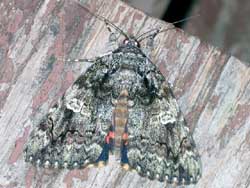
|
** 8801 Catocala ilia; Ilia; wingspan: 65-82mm. Several different forms, most have characteristic white area in and around reniform spot. Diffuse dark arc running from this spot to just below apex. Subreniform spot squarish, concave inner and outer edges and elongated constriction connecting it to pml. White dots near fw om in character with the overall "contrasting" appearance. |
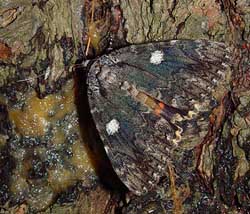
|
** 8801 Catocala ilia; Ilia; form conspicuaIn this form the entire reniform spot is heavily suffused with white scaling on an otherwise darker ground colour. Hence the form name "conspicua". Tim Dyson image. |
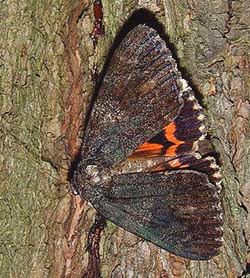
|
** 8801 Catocala ilia; Ilia; form satanasIn this melanic form the entire forewing, including the reniform spot is very dark. Hence the form name "satanas". The dark basal streak is still evident on this form. Tim Dyson image. |
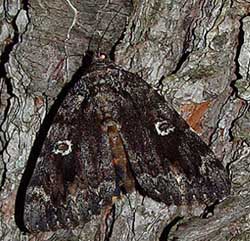
|
** 8801 Catocala ilia; Ilia; form normaniIn this semi-melanic form the entire forewing, excluding the reniform spot, is relatively dark. The brownish, kidney-shaped center of the reniform spot is outlined in white. The basal streak and subapical arc are still visible. Tim Dyson image. |
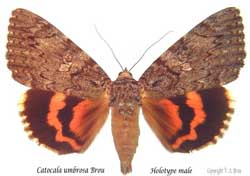
|
** 8857.1 Catocala umbrosa unconfirmed; mm; Double brown am line, inward line fainter, filled with off white; reniform spot brown center outlined in black , off white and black again; subreniform, large, pale brown, closed. Pm line wit htwo elongated upper teeth, next tooth reduced, next two progressively longer, rounded, final lobe rounded and shorter. HW with dark scaling/hairs in basal median area along im |
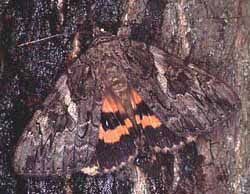
| ** 8771 Catocala piatrix ; Penitent, wingspan: 68-84mm. Fw: light-colored band/bar extending from light coloured, triangular subreniform spot along am line to costa. Brown, kidney-shaped reniform spot surrounded in pale grey, outlined in black, usually with distinct black along wing veins in a dark area outside the reniform spot. Hw: fringe lightly barred; lighter in color than deeper orange on rest of wing. |
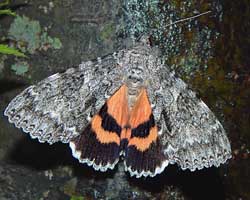
| ** 8805 unijuga; Once-married; wingspan: 70-90mm: Catocala unijuga has a fairly wide black inner band (almost reaching inner margin) in hindwing and very distinctive patterning in forewing. Meskei tend to have narrower band and dustier (less distinct) looking forewing. Semirelicta tend to have inner bands that terminate well before inner margins. Also note the very white fringe on both the forewings and hindwings. Carroll Rudy image. |
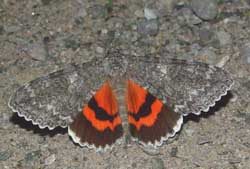
| ** 8805 unijuga; Once-married; 70-90mm.Form agatha has a much darker, evenly grey forewing. Hindwings have some darker hairs in basal area. Note very white fringe on both forewings & hindwings. June to october, willows |
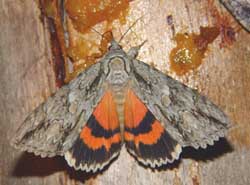
|
** 8806 Catocala parta; Mother Underwing, wingspan: 70-85mm. Black dashes in basal, subapical and anal areas help to identify this species. Hws may be yellow to yellowish-orange but more often are salmon-red. Note face-head-like markings on thorax. In the hindwing, the first (nearest the apex) black protrusion into the white fringe is "noticeably" larger than the others. |
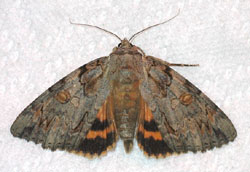
| ** 8798 Catocala neogama; wingspan 70-85mm. Brown head, thorax, larger size as compared to C. palaeogama. Neogama tend to be slightly smaller than subnata, have darker grey brown fws with more pronounced markings. Examination of hind tibia needed for id. Neogama's: flattened, unevenly, sparsely spined; subnata's: cylindrical, spines dense, uniform in distribution. Joe Garris photo. |
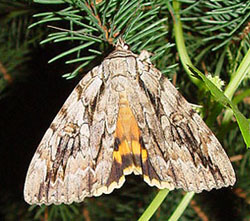
| ** 8797 Catocala subnata; Youthful Underwing: 75-90mm. Fws greyish white with blue-grey and light brown scales, usually with hws brighter yellow than those of neogama. Neogama usually have basal dash; absent in male subnata, but present in females. Magnification of hind tibia needed for id: subnata: cylindrical hind tibia; neogama: compressed or flattened hind tibia. subnata: ventral surface of tibia densely covered with evenly distributed spines; neogama: ventral surface of tibia sparsely covered. |
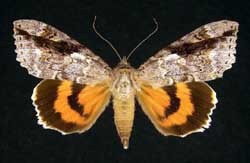
|
** 8804 C. marmorata;
Marbled; wingspan 85-95mm |
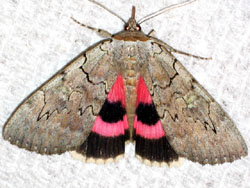
| ** 8833 concumbens
Sleepy Underwing or
Pink Underwing (wingspan: 60-75mm). |
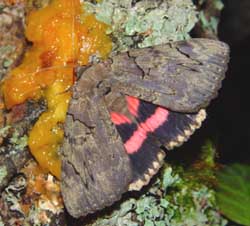
| ** 8832 Catocala cara; Darling; wingspan 70-85mm: Note deep maroon almost purple cast to forewings, mixed with very pale green. Lower half of am and pm lines is barely visible. There are no distinctive bars or dashes. Two upper "teeth" on the pm line are thin and long. The hindwing bands are pink. There is heavy black checking on the off-white hindwing fringe. The relatively thick black median band of the hindwing almost reaches the inner margin which is usually heavily adorned with dark hairs. Tim Dyson image. |
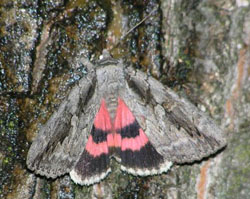
|
** 8834 amatrix Sweetheart Underwing; (wingspan 75-95mm). Very skittish and frequently hides in caves, under bridges, under tree bark, etc. by day, resting with head down. The hindwing patterning and colouration are similar to that of Catocala concumbens, but the large size (wingspan 75-95mm) and the dark bar running from the basal area to just below the apex distinguishes Catocala amatrix. |
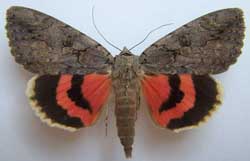
|
** 8834 amatrix form selecta
Sweetheart Underwing; (wingspan 75-95mm) |
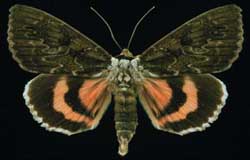
|
** 8834 amatrix form hesseli
Sweetheart Underwing; (wingspan 75-95mm) |
Return to Canadian Index
Return to Main Catocala Index
Enjoy some of nature's wonderments, giant silk moth cocoons. These cocoons are for sale winter and fall. Beautiful Saturniidae moths will emerge the following spring and summer. Read Actias luna rearing article. Additional online help available.
Use your browser "Back" button to return to the previous page.
This page is brought to you by Bill Oehlke and the WLSS. Pages are on space rented from Bizland. If you would like to become a "Patron of the Sphingidae/Catocala Sites", contact Bill.
Please send sightings/images to Bill. I will do my best to respond to requests for identification help.

|
butterfly to the left, a link to many worldwide insect sites. |
This website has been created and is maintained by Bill Oehlke without government or institutional financial assistance. All expenses, ie., text reference support material, webspace rental from Bizland, computer repairs/replacements, backups systems, software for image adjustments (Adobe Photoshop; L-View), ftp software, anti-virus protection, scanner, etc. are my own.
I very much appreciate all the many images that have been sent to me, or of which I have been granted permission to copy and post from other websites. All images on this site remain the property of respective photographers.
If you would like to contribute to the maintenace of this website by sending a contribution to
Bill Oehlke
Box 476
155 Peardon Road
Montague, Prince Edward Island, C0A1R0
Canada
your donation would be much appreciated and would be used for
1) paying for webspace rental;
2) paying for computer maintenance and software upgrades;
3) purchases of additional text reference material (journals and books) in anticipation of expanding the site to a worldwide Sphingidae site;
4) helping to pay my daughter's tuition; with anything left over going to humanitarian aid.
If you are mailing a check from USA, please use $1.10 postage (2013 postage rate). Donations can also be made through Paypal via the button below.